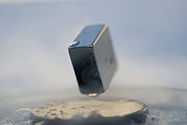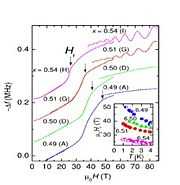Quantum oscillations (experimental technique)
| Condensed matter experiments |
|---|
 |
| ARPES |
| Neutron scattering |
| X-ray spectroscopy |
| Quantum oscillations |
| Scanning tunneling microscopy |
In condensed matter physics, Quantum oscillations describes an experimental technique to map the Fermi surface of a metal in the presence of a strong magnetic field.[1] The technique is based on the principle of Landau quantization of Fermions moving in a magnetic field.[2] For a gas of free fermions in a strong magnetic field, the energy levels are quantized into bands, called the Landau levels, whose separation is inversely proportional to the strength of the magnetic field. In a quantum oscillations experiment, the external magnetic field is varied, which causes the Landau levels to pass over the Fermi surface, which in turn results in oscillations of the Hall resistance.[2] Observation of quantum oscillations in a material is considered a signature of Fermi liquid behaviour.[3]
Quantum oscillations have been used to study high temperature superconducting materials such as cuprates and pnictides.[1] Studies using these experiments have shown that the ground state of underdoped cuprates behave similar to a Fermi liquid, and display characteristics such as Landau quasiparticles.[4]
Experiment
When a magnetic field is applied to a system of free Fermions, their energy states are quantized into the so-called Landau levels, given by[5]


for integer-valued  , where
, where  is the external magnetic field and
is the external magnetic field and  are the fermion charge and effective mass respectively.
are the fermion charge and effective mass respectively.
When the external magnetic field  is increased in an isolated system, the Landau levels expand, and eventually "fall off" the Fermi surface. This leads to oscillations in the observed energy of the highest occupied level, and hence in the Hall conductivity. The periodicity of these oscillations can be measured, and in turn can be used to determine the cross-sectional area of the Fermi surface.[6] If the axis of the magnetic field is varied at constant magnitude, similar oscillations are observed. The oscillations occur whenever the Landau orbits touch the Fermi surface. In this way, the complete geometry of the Fermi sphere can be mapped.[6]
is increased in an isolated system, the Landau levels expand, and eventually "fall off" the Fermi surface. This leads to oscillations in the observed energy of the highest occupied level, and hence in the Hall conductivity. The periodicity of these oscillations can be measured, and in turn can be used to determine the cross-sectional area of the Fermi surface.[6] If the axis of the magnetic field is varied at constant magnitude, similar oscillations are observed. The oscillations occur whenever the Landau orbits touch the Fermi surface. In this way, the complete geometry of the Fermi sphere can be mapped.[6]
Underdoped Cuprates
Studies of under-doped cuprate compounds such as YBCO through probes such as ARPES have indicated that these phases show characteristics of non-Fermi liquids,[7] and in particular, the absence of well-defined Landau quasiparticles.[8] However, quantum oscillations have been observed in these materials at low temperatures, if their superconductivity is suppressed by a sufficiently high magnetic field,[2] which is evidence for the presence of well-defined quasiparticles with Fermionic statistics. These experimental results thus disagree with those from ARPES and other probes.[5]
See also
- De Haas–van Alphen effect
- Landau levels
References
- ↑ 1.0 1.1 Coldea, Amalia (2010). "Quantum oscillations probe the normal electronic states of novel superconductors". Philosophical Transactions of the Royal Society A 368 (1924): 3503–3517. Bibcode:2010RSPTA.368.3503C. doi:10.1098/rsta.2010.0089. Retrieved 20 March 2012.
- ↑ 2.0 2.1 2.2 Doiron-Leyraud, Nicolas; et al (2007). "Quantum oscillations and the Fermi surface in an underdoped high-Tc superconductor". Nature 447 (7144): 565–8. arXiv:0801.1281. Bibcode:2007Natur.447..565D. doi:10.1038/nature05872. PMID 17538614. Retrieved 20 March 2012.
- ↑ Condensed-matter and materials physics: the science of the world around us. National Research Council. 2010. ISBN 0-309-13409-9.
- ↑ Broun, D. M. (2008). "What lies beneath the dome?". Nature Physics 4 (3): 170–172. Bibcode:2008NatPh...4..170B. doi:10.1038/nphys909. Retrieved 20 March 2012.
- ↑ 5.0 5.1 Sebastian, Suchitra E.; Neil Harrison; Gilbert G. Lonzarich (2011). "Quantum oscillations in the high-Tc cuprates". Philosophical Transactions of the Royal Society A 369 (1941): 1687–1711. Bibcode:2011RSPTA.369.1687S. doi:10.1098/rsta.2010.0243. Retrieved 23 March 2012.
- ↑ 6.0 6.1 Ibach, Harald; Hans Lüth (1995). Solid-state physics: an introduction to principles of materials science. Berlin: Springer-Verlag. ISBN 3-540-58573-7.
- ↑ Alexandrov, A. S. (2008). "Theory of quantum magneto-oscillations in underdoped cuprate superconductors". Journal of Physics: Condensed Matter 20 (19). arXiv:0711.0093. Bibcode:2008JPCM...20s2202A. doi:10.1088/0953-8984/20/19/192202. Retrieved 25 March 2012.
- ↑ Damascelli, Andrea; Hussain, Zahid; Zhi-Xun Shen (2003). "Angle-resolved photoemission studies of the cuprate superconductors". Reviews of Modern Physics 75 (2). arXiv:cond-mat/0208504. Bibcode:2003RvMP...75..473D. doi:10.1103/RevModPhys.75.473. Retrieved 25 March 2012.